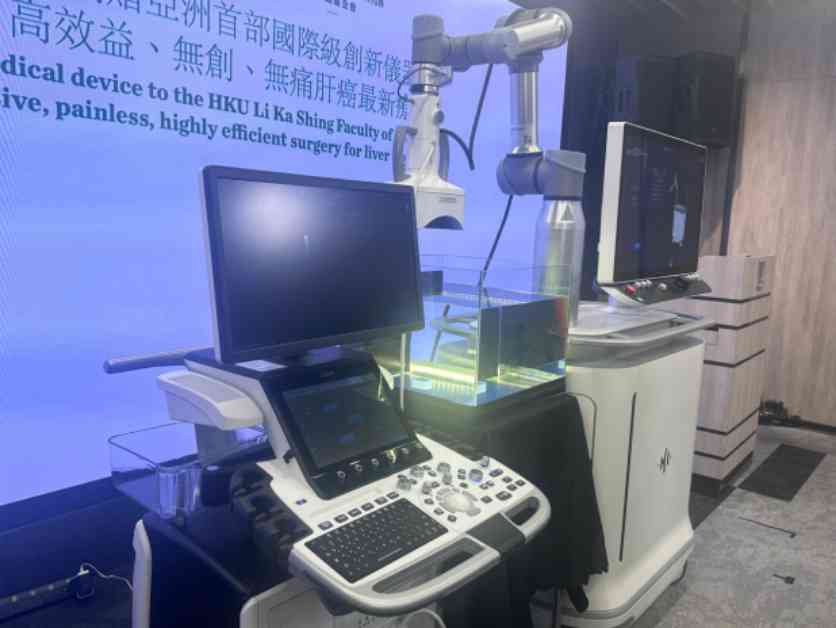The University of Hong Kong’s faculty of medicine is set to embark on groundbreaking clinical trials in Asia involving a cutting-edge device that utilizes sound waves to treat cancer. This innovative approach, known as histotripsy, will be tested on twenty liver cancer patients at Queen Mary Hospital starting in September.
Histotripsy involves the use of high-intensity ultrasound to induce a sudden expansion and collapse of cancer cells, creating shock waves that break down and liquefy the cancer cells. Professor Albert Chan from the University of Hong Kong explained that this process effectively kills the cancer cells without the need for invasive procedures, scars, or wounds. This non-radiation treatment offers a promising alternative for a broad spectrum of patients, with the potential to revolutionize cancer treatment in Hong Kong and beyond.
Liver cancer is a significant health concern in Hong Kong, ranking as the fifth most common cancer with approximately 1,700 to 1,800 new cases reported each year. The introduction of histotripsy as a treatment option represents a major advancement in the field of oncology, offering hope for patients battling this deadly disease. Professor Chan emphasized the importance of this clinical trial in evaluating the efficacy and safety of histotripsy for liver cancer patients, paving the way for future applications in other types of cancer.
HistoSonics CEO Mike Blue on the Potential of Sound Wave Cancer Treatment
Mike Blue, a representative of the manufacturer of the histotripsy device, expressed optimism about the technology’s potential to revolutionize cancer treatment across various types of cancer. He highlighted the versatility of the system, noting that it could potentially be used to treat cancers ranging from the neck down. Blue envisioned a future where histotripsy could be applied to treat thyroid, breast, sarcomas, liver, kidney, pancreas, and other types of cancer, offering a non-invasive and effective treatment option for patients.
According to Blue, histotripsy has already shown promising results in the United States, demonstrating its effectiveness in treating both early and advanced stages of cancer. The technology has the potential to benefit recurrent cancer patients as well, providing a viable treatment option for those who have previously undergone traditional therapies. The success of the clinical trial on liver cancer at the University of Hong Kong will serve as a springboard for further studies on different types of cancer, including kidney and pancreatic cancer, in the Special Administrative Region (SAR).
The Impact of Sound Wave Cancer Treatment on Oncology
The introduction of histotripsy as a novel approach to cancer treatment has the potential to transform the landscape of oncology by offering a non-invasive and targeted therapy for patients with various types of cancer. The ability of sound waves to effectively break down and liquefy cancer cells without causing harm to surrounding healthy tissue makes histotripsy a promising alternative to traditional treatments such as surgery, chemotherapy, and radiation therapy.
The minimally invasive nature of histotripsy not only reduces the risk of complications and side effects but also enhances the quality of life for cancer patients undergoing treatment. By eliminating the need for incisions, scars, and prolonged recovery periods, histotripsy offers a more patient-friendly approach to cancer care, allowing individuals to resume their daily activities sooner and with improved overall well-being.
The versatility of histotripsy in targeting different types of cancer holds significant promise for the future of oncology, offering a personalized and tailored treatment option for patients based on their specific diagnosis and needs. The potential expansion of histotripsy to other types of cancer beyond liver cancer opens up new possibilities for improving outcomes and survival rates for a wide range of cancer patients, ultimately contributing to advancements in the field of cancer research and treatment.
The Future of Sound Wave Cancer Treatment in Hong Kong
As the University of Hong Kong embarks on the first clinical trials of histotripsy in Asia, the future of sound wave cancer treatment in Hong Kong looks promising. The completion of the clinical trial on liver cancer patients at Queen Mary Hospital will provide valuable insights into the efficacy and safety of histotripsy as a treatment option for this particular type of cancer, laying the groundwork for future studies on other types of cancer in the SAR.
The collaboration between academia, healthcare providers, and industry partners in advancing the field of oncology through innovative technologies like histotripsy underscores Hong Kong’s commitment to excellence in healthcare and research. The potential for histotripsy to become a standard of care for cancer treatment in the region holds immense promise for improving patient outcomes, reducing healthcare costs, and advancing the overall quality of cancer care in Hong Kong and beyond.
In conclusion, the introduction of sound wave cancer treatment through histotripsy represents a significant milestone in the field of oncology, offering a non-invasive, targeted, and effective treatment option for patients with various types of cancer. The ongoing clinical trials at the University of Hong Kong mark the beginning of a new era in cancer care, with the potential to revolutionize treatment approaches and improve outcomes for cancer patients in Hong Kong and beyond.



















